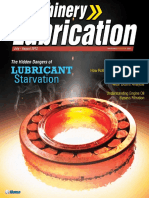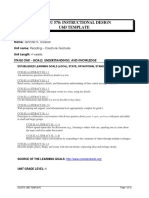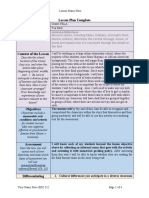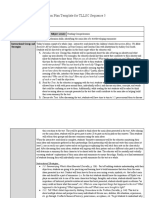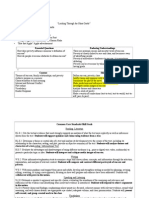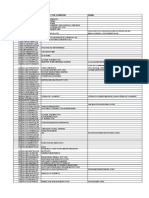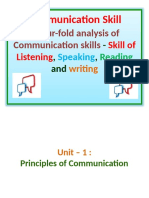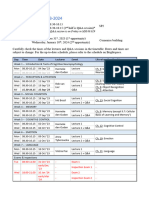0 ratings0% found this document useful (0 votes)
48 viewsFamous Quotes For Theme Analysis: by Cecilia Gregg
Famous Quotes For Theme Analysis: by Cecilia Gregg
Uploaded by
Abduljabar ALAmeriThis document provides guidance on using theme analysis to teach English language learners critical thinking skills. It discusses selecting quotes at varying levels of difficulty and walking students through a process of paraphrasing, reviewing literary elements, and identifying themes. For lower-level students, quotes should be shorter and simpler, while higher-level students can handle longer quotes and a less structured approach. Examples of quotes used are provided, along with tips for finding suitable quotes from various sources. Teachers should choose quotes relevant to students and at an appropriate difficulty level to both challenge and engage them.
Copyright:
© All Rights Reserved
Available Formats
Download as PDF, TXT or read online from Scribd
Famous Quotes For Theme Analysis: by Cecilia Gregg
Famous Quotes For Theme Analysis: by Cecilia Gregg
Uploaded by
Abduljabar ALAmeri0 ratings0% found this document useful (0 votes)
48 views4 pagesThis document provides guidance on using theme analysis to teach English language learners critical thinking skills. It discusses selecting quotes at varying levels of difficulty and walking students through a process of paraphrasing, reviewing literary elements, and identifying themes. For lower-level students, quotes should be shorter and simpler, while higher-level students can handle longer quotes and a less structured approach. Examples of quotes used are provided, along with tips for finding suitable quotes from various sources. Teachers should choose quotes relevant to students and at an appropriate difficulty level to both challenge and engage them.
Original Title
etf_57_1_35-38
Copyright
© © All Rights Reserved
Available Formats
PDF, TXT or read online from Scribd
Share this document
Did you find this document useful?
Is this content inappropriate?
This document provides guidance on using theme analysis to teach English language learners critical thinking skills. It discusses selecting quotes at varying levels of difficulty and walking students through a process of paraphrasing, reviewing literary elements, and identifying themes. For lower-level students, quotes should be shorter and simpler, while higher-level students can handle longer quotes and a less structured approach. Examples of quotes used are provided, along with tips for finding suitable quotes from various sources. Teachers should choose quotes relevant to students and at an appropriate difficulty level to both challenge and engage them.
Copyright:
© All Rights Reserved
Available Formats
Download as PDF, TXT or read online from Scribd
Download as pdf or txt
0 ratings0% found this document useful (0 votes)
48 views4 pagesFamous Quotes For Theme Analysis: by Cecilia Gregg
Famous Quotes For Theme Analysis: by Cecilia Gregg
Uploaded by
Abduljabar ALAmeriThis document provides guidance on using theme analysis to teach English language learners critical thinking skills. It discusses selecting quotes at varying levels of difficulty and walking students through a process of paraphrasing, reviewing literary elements, and identifying themes. For lower-level students, quotes should be shorter and simpler, while higher-level students can handle longer quotes and a less structured approach. Examples of quotes used are provided, along with tips for finding suitable quotes from various sources. Teachers should choose quotes relevant to students and at an appropriate difficulty level to both challenge and engage them.
Copyright:
© All Rights Reserved
Available Formats
Download as PDF, TXT or read online from Scribd
Download as pdf or txt
You are on page 1of 4
Famous Quotes for Theme
Analysis
by CECILIA GREGG
Theme analysis requires students to examine low-level students, quotes should be
information and isolate patterns—or shorter and/or simpler, and themes may be
themes—to determine meaning. Analyzing limited. Here is a quote from John Muir,
themes from written material helps English a conservationist, writer, and activist, that
language learners practice and demonstrate may be suitable for students at the low or
higher-level critical-thinking skills. I find intermediate level:
that students crave participating in engaging
group activities and want to discuss personally “When we try to pick out anything
meaningful topics, like interpersonal by itself, we find it hitched to
relationships, social and cultural issues, and everything else in the universe.”
current events that affect them.
Students need to understand the concept
One of my goals is to provide memorable, of “universe” and vocabulary like hitched to
relevant activities—like this theme-analysis analyze the quote effectively. As teachers,
task—that motivate students and encourage we want to encourage students to learn new
them to look at the world from new vantage words and stretch their English-language
points. As an English Language Fellow at boundaries. Teachers should select quotes
Hebron University in the West Bank, I have that build on the existing knowledge of
used this activity with students who are students and challenge them with new
generally 18 to 20 years old. Their English concepts. Themes that could emerge from
proficiency level is low to midrange; however, an analysis of this quote include community,
the activity can be used with students at all interconnectedness, and even faith. Again,
levels.
Websites that list quotes vary widely.
SELECTING QUOTES
Typical online searches can yield results
Finding suitable quotes for students to for general and specific quotes. For
analyze in this activity is an easy task for example, search “quotes from children’s
both teachers and students, as there are literature” or “inspirational quotes” for a
hundreds of websites dedicated to the variety of quotes to use for this activity;
collection of quotations. Teachers can select you can also search for quotes from
the quotes based on current or past class movies, quotes by a specific person, or
objectives and topics; choose quotes from quotes about a topic that is relevant and
various authors, personal heroes, religious of interest to your students.
figures, philosophers, or politicians; and
Textbooks, journal articles, videos,
use quotes from English songs or movies.
and other classroom materials are also
Teachers can also involve the students in
sources of quotes. From time to time,
the quote-selection process. Figure 1 suggests
popular magazines and online journals
tips for finding quotes.
provide top quotes. Additionally, social-
media sites are sources of quotes to use
In selecting quotes for the activity, teachers
for theme analysis.
must consider students’ vocabulary,
comprehension level, and interest. For Figure 1. Tips for finding quotes
americanenglish.state.gov/english-teaching-forum 2019 ENGLISH TEACHING FORUM 35
With high-level students, a less-structured
approach is favorable. Because student
comprehension levels are higher, the step-
by-step approach may not be needed. Using
When we try to pick a simple “Who, What, When, Why, Where?”
out anything by itself, approach may be enough. Students can use
this approach to gain insight into the quote
we find it hitched to and the intended meaning of the author by
answering the Wh– questions. High-level
everything else in the students can also articulate sophisticated
universe. concepts by identifying, selecting, and
defending their ideas and perspectives about
the quotes, based on their own experience and
ideas about the relevant themes.
I have used the following quote from Henry
David Thoreau in the theme-analysis activity:
these ideas should not be too far outside the
scope of the students’ language capacity. “I went to the woods because I
wished to live deliberately, to front
THEME-ANALYSIS PROCESS only the essential facts of life, and
see if I could not learn what it had
Although there are many ways to analyze a to teach, and not, when I came to
quote, the “paraphrase, review, and evaluate” die, discover that I had not lived.”
approach is useful. In low-level classrooms,
students first try to understand the quote and I selected the quote because it focuses on
paraphrase it in their own words. Paraphrasing objectives identified in the comparative
allows the student to identify main ideas of literature course with which I was working.
the quote and demonstrate understanding of Because students were puzzled by the meaning
the context. Once a student has completed of front as used in this quote, they used their
the paraphrasing step, the teacher can provide dictionaries to bring meaning to the word
feedback and ask critical-thinking questions, in the context of the quote. Throughout
which can guide the student toward deeper the activity, I provided feedback by asking
understanding. students their ideas and gently guiding them.
After the individual process was complete, I
Next, students can review the quote and answered questions and helped student groups
note the tone, mood, diction, and figurative through an analysis process, where all students
language. By exploring the literary elements shared their ideas. Once the analysis was
of the quote, students begin to understand complete, students determined that the theme
the meaning of the quote from the author’s of the quote was “living life fully.”
perspective. Again, the teacher can provide
input to ensure that the student analysis is on Another quote I have used is the following,
track. from Mark Victor Hansen, a motivational
speaker and author:
Finally, students evaluate the quote and
identify the author’s intended message to the “Don’t wait until everything is
reader. In this stage, students can provide a just right. It will never be perfect.
written summary of the quote, identifying key There will always be challenges,
messages. The teacher again plays a supporting obstacles and less than perfect
role in the process, providing feedback and conditions. So what. Get started
assisting students in the theme analysis. now. With each step you take,
36 ENGLISH TEACHING FORUM 2 01 9 americanenglish.state.gov/english-teaching-forum
you will grow stronger and INSTRUCTIONS
stronger, more and more
skilled, more and more self- 1. Find five or more quotes. Select them
confident and more and more based on the English proficiency level
successful.” of the students, course objectives,
and topics of interest. Quotes should
I found this quote through an Internet search include some vocabulary that students
and selected it based on a teaching goal to are not familiar with.
inspire students to overcome challenges.
Students used the “paraphrase, review, and 2 . Write or type the quotes on slips of
evaluate” approach to analyze the quote, first paper. Make enough copies so each
individually and then collectively. They used student will have his or her own copy of
their dictionaries to review the words obstacles the quote. For instance, if you have
and self-confident. I provided feedback, and 25 students and you are using five
after the group discussion, students decided quotes, make five copies of each quote.
that the overarching theme for this quote
was “[free] will.” 3 . Randomly hand out a quote to each
student, distributing the quotes so that
Other themes that emerged from the roughly an equal number of students are
quote-analysis activity were freedom, assigned to each quote.
love, friendship, and [positive] attitude.
The activity was a fun way for students to 4 . Give students about five minutes
use their conversation skills, in a group to read the quote, work through an
setting, to discuss the thoughts of literary analysis process, and use the dictionary
figures, religious leaders, and political to look up words with which they are
leaders. Students also used reading, writing, unfamiliar. The initial review of the
collaborative, and critical-thinking skills. quote should be an individual activity
During the activity, they worked alone and for students.
in groups. They reported that the activity
provided them with a new outlet for 5 . Provide feedback to students about
reviewing written material and literature, their understanding of the quotes and
and they mentioned that the activity could guide them by asking critical-thinking
be used in various academic and personal questions such as, “What message do
contexts, such as song-lyric analysis. you think the person was trying to
convey?”; “What did this quote make
PREPARATION you think of when you first read it?”;
and “When you read the quote, how do
The activity requires minimal supplies you feel, and why do you feel that way?”
and technology. Supplies include quotes,
handwritten or typed on slips of paper, 6 . Ask students to individually write the
on a range of topics aligned with class definitions of new vocabulary and the
objectives. It is also helpful to have meaning of the quote in their own
dictionaries, pens, paper, and, of course, words.
interested students. The quotes should
include both familiar and unfamiliar 7. Group students according to the quotes.
vocabulary; including a range of vocabulary There should be five (or more) groups,
words encourages students to use their and each student in the group should
dictionaries and learn new vocabulary. have reviewed the same quote.
A goal of the activity should be to increase
student comprehension of the theme-analysis 8 . Give students about ten minutes to
process and content of the quotes. discuss their personal understanding
americanenglish.state.gov/english-teaching-forum 2019 ENGLISH TEACHING FORUM 37
of the quote with group members.
Students should also discuss the
meaning of vocabulary that is new to
them.
There will always be
9 . Ask students to work as a group to challenges, obstacles
write their understanding of the
quote and determine a theme for and less than perfect
the quote.
conditions. So what.
1 0 . Ask each group to present its findings Get started now.
to the class by reading the quote,
identifying one new vocabulary
word, and suggesting a theme for
the quote.
1 1 . While each group is presenting, the
other students should summarize The activity can be repeated with additional
the presentations by writing down quotes from different authors, genres, time
a few brief sentences or ideas. This periods, or themes. It can be reflective, based
helps all students stay focused during on content covered in previous lessons, or
the activity and get the benefit of it can be forward-focused, introducing new
the lesson. topics and objectives.
REFLECTION In addition to improving group skills,
this activity can strengthen conversation,
Quote analysis is a worthwhile and enjoyable dictionary-use, reading, writing, and critical-
stand-alone activity; it can also be a starting thinking skills, and it encourages students to
point for other activities. For example, think and learn in an innovative way.
after the initial quote analysis, the teacher
can ask students to do any or all of the
following: Cecilia Gregg earned her doctorate degree in
Education from University of Phoenix. Cecilia has
• Write a dialogue about a theme identified also studied business, psychology, and TEFL. She
in the initial quotes. enjoys living in the West Bank, and prior to her work
as an English Language Fellow, Cecilia served in the
• Create skits using the themes identified in U.S. Peace Corps in Chongqing, China, and taught at
the initial quotes. Arizona State University and University of Phoenix.
• Recall vocabulary from each presentation.
• Research the context or authors of the
quotes.
• Create a visual representation of a quote.
• Write a new, meaningful quote with a
theme of their choice.
• Analyze the group process, considering the
stages of working in a team setting.
38 ENGLISH TEACHING FORUM 2 01 9 americanenglish.state.gov/english-teaching-forum
You might also like
- Supply Chain Management of Colgate PalmoliveDocument12 pagesSupply Chain Management of Colgate PalmoliveSai Vasudevan88% (8)
- When Kids Can't ReadDocument67 pagesWhen Kids Can't ReadjmelvinuabNo ratings yet
- Placement Test: Ventures Placement Test Version 2.0 © Cambridge University Press 2014 Photocopiable Page 1 of 13Document13 pagesPlacement Test: Ventures Placement Test Version 2.0 © Cambridge University Press 2014 Photocopiable Page 1 of 13Abduljabar ALAmeriNo ratings yet
- Ventures Level 1 Unit 3 Picture Dictionary ActivityDocument1 pageVentures Level 1 Unit 3 Picture Dictionary ActivityAbduljabar ALAmeri100% (1)
- Solar radiation-WSDocument2 pagesSolar radiation-WSPrisha GargNo ratings yet
- ML July August 2012Document53 pagesML July August 2012rona41brNo ratings yet
- Itl 520 Learning MapDocument7 pagesItl 520 Learning Mapapi-535727969No ratings yet
- Afoa Annotated BibDocument20 pagesAfoa Annotated Bibapi-720953259No ratings yet
- Using Reflection For AssessmentDocument2 pagesUsing Reflection For AssessmentTomika RodriguezNo ratings yet
- Module 1 For EAPPDocument20 pagesModule 1 For EAPPKristinne Claire Renol ReyesNo ratings yet
- Oup Focus Visible Thinking PDFDocument5 pagesOup Focus Visible Thinking PDFFranc NearyNo ratings yet
- Reading Literary TextsDocument11 pagesReading Literary TextsJohannin Cazar ArevaloNo ratings yet
- Implemented Lesson Analysis 2Document5 pagesImplemented Lesson Analysis 2api-663093380No ratings yet
- Lesson 12 Developing Childrens Understanding of Literary TextsDocument12 pagesLesson 12 Developing Childrens Understanding of Literary TextsEloisa MarbellaNo ratings yet
- Lesson PlanDocument6 pagesLesson Planapi-349867790No ratings yet
- Lesson 1Document28 pagesLesson 1Roushiell LondonNo ratings yet
- Instruction - Education ProfessionDocument12 pagesInstruction - Education Professionapi-290520820No ratings yet
- Pedagogical Approaches To Improving Reading ComprehensionDocument16 pagesPedagogical Approaches To Improving Reading ComprehensionLory-Anne PanemNo ratings yet
- Reading: Mia Pearl R. RapatanDocument30 pagesReading: Mia Pearl R. RapatanJulie Ann GernaNo ratings yet
- LS4 HWDocument5 pagesLS4 HWMaide GelengecNo ratings yet
- Week Seven Journal PromptDocument4 pagesWeek Seven Journal Promptapi-383904435No ratings yet
- 8.teaching For Comprehension & Comprehension StrategiesDocument10 pages8.teaching For Comprehension & Comprehension StrategiesairaNo ratings yet
- Lesson Plan Template Grade/Content Area Lesson Title State StandardsDocument4 pagesLesson Plan Template Grade/Content Area Lesson Title State Standardsapi-404244796No ratings yet
- Academic Assesment of Student LearningDocument3 pagesAcademic Assesment of Student Learningapi-558321989No ratings yet
- Reading Experience Lesson Plan EDIS 5401: English Education: ContextDocument11 pagesReading Experience Lesson Plan EDIS 5401: English Education: Contextapi-341089240No ratings yet
- Najiyah Bello - Lesson Plan 2Document15 pagesNajiyah Bello - Lesson Plan 2api-470362666No ratings yet
- LESSON 5 - ExploreDocument4 pagesLESSON 5 - ExploreDora ShaneNo ratings yet
- Reading ComprehensionDocument2 pagesReading ComprehensionLeslie Peramide IgnoroNo ratings yet
- Critical Reading, Using Reading Prompts To Promote Active Engagement With Text Final PDFDocument6 pagesCritical Reading, Using Reading Prompts To Promote Active Engagement With Text Final PDFemysamehNo ratings yet
- Reading Comprehension Strategies - MooreDocument4 pagesReading Comprehension Strategies - MooreNorjunaidi Zakaria100% (1)
- Rationale Theory: Common Misconceptions/ DifficultiesDocument4 pagesRationale Theory: Common Misconceptions/ Difficultiesapi-356513456No ratings yet
- Assignment 3 Writing FinalDocument16 pagesAssignment 3 Writing Finalapi-535000563No ratings yet
- Module 4 Talits Reviewer Finals 1Document3 pagesModule 4 Talits Reviewer Finals 1Eari FujiyamaNo ratings yet
- Ais's Abstract For UnesaDocument202 pagesAis's Abstract For UnesaSiti AisyahNo ratings yet
- Article Analysis 2Document3 pagesArticle Analysis 2api-340960709No ratings yet
- Higher Order ThinkingDocument15 pagesHigher Order ThinkingDelikanliXNo ratings yet
- Read-Pair-Share Lesson PlanDocument4 pagesRead-Pair-Share Lesson Planapi-707767130No ratings yet
- Study of Student Achievement 2Document23 pagesStudy of Student Achievement 2api-543821252No ratings yet
- Read Aloud StrategyDocument2 pagesRead Aloud Strategyapi-248208787No ratings yet
- Topic/Lesson Name The Process of Review of Related Literature (RRL)Document6 pagesTopic/Lesson Name The Process of Review of Related Literature (RRL)Emay Jean PescaderoNo ratings yet
- 6th Grade Language ArtsDocument11 pages6th Grade Language ArtsKracel AvelinoNo ratings yet
- Miller With Mark UpspdfDocument7 pagesMiller With Mark Upspdfapi-42688552No ratings yet
- Application of Theory To PracticeDocument9 pagesApplication of Theory To Practiceapi-457392166No ratings yet
- Reading Comprehension Strategies For Elementary Students - Always A Teacher.Document9 pagesReading Comprehension Strategies For Elementary Students - Always A Teacher.Mary ChildNo ratings yet
- Cep Lesson Plan 2Document9 pagesCep Lesson Plan 2api-690650522No ratings yet
- English Lesson Plan 2Document4 pagesEnglish Lesson Plan 2api-518990010No ratings yet
- Finance Professors' Use of Case Discussion Leadership at Harvard and Darden MBA Programs: Qualities of A Successful Case Discussion LeaderDocument26 pagesFinance Professors' Use of Case Discussion Leadership at Harvard and Darden MBA Programs: Qualities of A Successful Case Discussion Leaderjustin_playboyNo ratings yet
- Chapter 6Document5 pagesChapter 6Madelʚĭɞ Bernardo GatanNo ratings yet
- IrprojectartifactDocument2 pagesIrprojectartifactapi-285526151No ratings yet
- Center For Educational Innovation: Writing Your Teaching PhilosophyDocument6 pagesCenter For Educational Innovation: Writing Your Teaching PhilosophyClifford MantleNo ratings yet
- Ya Lit Unit Plan WrevisionsDocument17 pagesYa Lit Unit Plan Wrevisionsapi-224612708No ratings yet
- Cass Summary InformationDocument2 pagesCass Summary InformationjaleeeNo ratings yet
- Topic/Lesson Name Standard Styles in Related Literature (RRL), Citation or ReferencesDocument6 pagesTopic/Lesson Name Standard Styles in Related Literature (RRL), Citation or ReferencesEmay Jean PescaderoNo ratings yet
- Instructional PlanDocument19 pagesInstructional Planapi-354007473100% (1)
- Levels of ComprehensionDocument3 pagesLevels of ComprehensionJezza Gillado Tarayao100% (1)
- The 5 E Instructional Model by CNLDocument64 pagesThe 5 E Instructional Model by CNLCB Ana SottoNo ratings yet
- Adrienne Gear - Powerful Understanding - Helping Students Explore, Question, and Transform Their Thinking About Themselves and The World Around Them-Pembroke Publishers, Limited (2018)Document173 pagesAdrienne Gear - Powerful Understanding - Helping Students Explore, Question, and Transform Their Thinking About Themselves and The World Around Them-Pembroke Publishers, Limited (2018)Grace WNo ratings yet
- 5E Lesson Plan Template: HS.2SS.C4.PO1 - The Highly Proficient Student Can Connect Ideas of TheDocument4 pages5E Lesson Plan Template: HS.2SS.C4.PO1 - The Highly Proficient Student Can Connect Ideas of Theapi-324796495No ratings yet
- Oup Focus Inquiry Based LearningDocument4 pagesOup Focus Inquiry Based LearningVanesa AbadiaNo ratings yet
- Duque, Angelica C. Bsed Ii-Filipino Inquiry Based Learning: Mabalacat City College Institute of Teacher EducationDocument12 pagesDuque, Angelica C. Bsed Ii-Filipino Inquiry Based Learning: Mabalacat City College Institute of Teacher EducationAngelica Cunanan DuqueNo ratings yet
- TAsk No 2 Why Do They Say That Our English Is BadDocument6 pagesTAsk No 2 Why Do They Say That Our English Is BadMary Grace Moso Arabilla67% (3)
- Day 1 5 Lesson PlanDocument5 pagesDay 1 5 Lesson Planapi-510196808No ratings yet
- Teaching Literature & Writing in the Secondary School ClassroomFrom EverandTeaching Literature & Writing in the Secondary School ClassroomNo ratings yet
- AbecedarioDocument1 pageAbecedarioLINo ratings yet
- American English File Starter Student 39 S Book 105Document1 pageAmerican English File Starter Student 39 S Book 105Abduljabar ALAmeriNo ratings yet
- Zoo Shoots and Kills Gorilla: Grammar in The NewsDocument3 pagesZoo Shoots and Kills Gorilla: Grammar in The NewsAbduljabar ALAmeriNo ratings yet
- How To Use The Picture Dictionary CardsDocument2 pagesHow To Use The Picture Dictionary CardsAbduljabar ALAmeriNo ratings yet
- 2,000-Year-Old Butter: Grammar in The NewsDocument4 pages2,000-Year-Old Butter: Grammar in The NewsAbduljabar ALAmeriNo ratings yet
- VENTURES2ED - RealLifeDocuments Level1 AllDocument10 pagesVENTURES2ED - RealLifeDocuments Level1 AllAbduljabar ALAmeriNo ratings yet
- VENTURES2ED PictureDictionary Level1 Flashcards Unit01Document9 pagesVENTURES2ED PictureDictionary Level1 Flashcards Unit01Abduljabar ALAmeriNo ratings yet
- VENTURES2ED VocabularyIndex-Level1Document5 pagesVENTURES2ED VocabularyIndex-Level1Abduljabar ALAmeriNo ratings yet
- My Classroom: ColombiaDocument5 pagesMy Classroom: ColombiaAbduljabar ALAmeriNo ratings yet
- Ventures Level 1 Unit 2 Picture Dictionary ActivityDocument1 pageVentures Level 1 Unit 2 Picture Dictionary ActivityAbduljabar ALAmeriNo ratings yet
- Introduction-To-business-management Certificate of Achievement Qbha9p7Document2 pagesIntroduction-To-business-management Certificate of Achievement Qbha9p7Abduljabar ALAmeriNo ratings yet
- Maher Zain - Never Forget LyricsDocument2 pagesMaher Zain - Never Forget LyricsAbduljabar ALAmeriNo ratings yet
- Maher Zain - One Big Family LyricsDocument2 pagesMaher Zain - One Big Family LyricsAbduljabar ALAmeriNo ratings yet
- Maher Zain - Medina LyricsDocument2 pagesMaher Zain - Medina LyricsAbduljabar ALAmeriNo ratings yet
- Book Item 99445Document18 pagesBook Item 99445salsabila fitristantiNo ratings yet
- Reference:: Fox and Mcdonald'SDocument8 pagesReference:: Fox and Mcdonald'SKristy ToumaNo ratings yet
- No Email Id DetailsDocument89 pagesNo Email Id DetailsvikrantNo ratings yet
- Alexander Lowen - The Language of The Body (Physical Dynamics of Character Structure) (1958, Psychology, Freud)Document404 pagesAlexander Lowen - The Language of The Body (Physical Dynamics of Character Structure) (1958, Psychology, Freud)Barbara Kubiec75% (4)
- Bidding Form No. 5 Bill of Materials - 0Document6 pagesBidding Form No. 5 Bill of Materials - 0Kim Aljon CalveloNo ratings yet
- 0AYMM-EN002D_YMseries_OPM_20240117Document112 pages0AYMM-EN002D_YMseries_OPM_20240117edmundfongNo ratings yet
- Suzlon One Earth-1Document4 pagesSuzlon One Earth-1Arun AhlawatNo ratings yet
- Evs & Science Blue Print - TsDocument4 pagesEvs & Science Blue Print - TsVenkat SwamyNo ratings yet
- USA Volcakeys MIDI Chart E PDFDocument1 pageUSA Volcakeys MIDI Chart E PDFSoKo RodrigoNo ratings yet
- Daniel Gebreyohannes - Final - Report - METEC PDFDocument42 pagesDaniel Gebreyohannes - Final - Report - METEC PDFdaniel100% (5)
- Test17 Module1Document27 pagesTest17 Module1Daeun KangNo ratings yet
- Brochure Air Compressors XHP900 1070T1Document4 pagesBrochure Air Compressors XHP900 1070T1Ichou MohamedNo ratings yet
- Backhoe Loader Delivery Service RecordChecklistDocument2 pagesBackhoe Loader Delivery Service RecordChecklistFaisal BackrieNo ratings yet
- 27.0 - Confined Spaces v3.1 English - UpdatedDocument14 pages27.0 - Confined Spaces v3.1 English - UpdatedjbdejhiuhwNo ratings yet
- Firaol Internship 2017Document33 pagesFiraol Internship 2017Firaol OromoNo ratings yet
- Communicationskillunit1 - LSRWDocument187 pagesCommunicationskillunit1 - LSRWjasjisha4No ratings yet
- MY CV - ResumeDocument1 pageMY CV - ResumeAminu UmarNo ratings yet
- Determination of Pull Up RatioDocument1 pageDetermination of Pull Up Ratiomayamohan72520% (5)
- The Interplay Between Internal and External Load Parameters During Different Strength Training Sessions in Resistance-Trained MenDocument28 pagesThe Interplay Between Internal and External Load Parameters During Different Strength Training Sessions in Resistance-Trained MenGabrielDosAnjosNo ratings yet
- B&C3 2023-24 Course Schedule For StudentsDocument1 pageB&C3 2023-24 Course Schedule For Studentsalu0101474519No ratings yet
- Zbrush ManimalDocument0 pagesZbrush ManimalEsteban Plazas100% (3)
- 卡尔文和霍布斯的作业Document7 pages卡尔文和霍布斯的作业afefktgcl100% (1)
- Meiosis Homework WorksheetDocument5 pagesMeiosis Homework Worksheetzoldoiwlf100% (1)
- ANSWER: Dye Penetrant Test Explanation:: No Explanation Is Available For This Question!Document4 pagesANSWER: Dye Penetrant Test Explanation:: No Explanation Is Available For This Question!shyamkumar rakoti0% (1)
- Kurikulum Program Studi S1 Teknik Sipil Fakultas Teknik TAHUN AJARAN 2019/2020Document10 pagesKurikulum Program Studi S1 Teknik Sipil Fakultas Teknik TAHUN AJARAN 2019/2020yanda adhaNo ratings yet
- Chapter 1 Lecture 1Document29 pagesChapter 1 Lecture 1Tyla CoetzeeNo ratings yet
- Zoho AddonsDocument3 pagesZoho AddonsCookie CluverNo ratings yet





